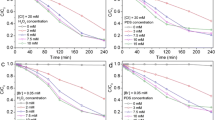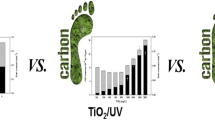Abstract
Residual H2O2 from UV/H2O2 treatment can be quenched by thiosulfate, bisulfite, and chlorine, but the kinetics of these reactions have not been reported under the full range of practical conditions. In this study, the rates of H2O2 quenching by these compounds were compared in different water matrices, temperatures, pH, and when using different forms of bisulfite and chlorine. In general, it was confirmed that thiosulfate would be too slow to serve as a quenching agent in most practical scenarios. At pH 7–8.5, chlorine tends to quench H2O2 more than 20 times faster than bisulfite in the various conditions tested. An important observation was that in lightly-buffered water (e.g., alkalinity of 20 mg/L as CaCO3), the form of chlorine can have a large impact on quenching rate, with gaseous chlorine slowing the reaction due to its lowering of the pH, and hypochlorite having the opposite effect. These impacts will become less significant when water buffer capacity (i.e., alkalinity) increases (e.g., to 80 mg/L as CaCO3). In addition, water temperature should be considered as the time required to quench H2O2 by chlorine at 4 °C is up to 3 times longer than at 20 °C.

Similar content being viewed by others
References
Breytenbach L, van Pareen W, Pienaar J J, van Eldik R (1994). The influence of organic acids and metal ions on the kinetics of the oxidation of sulfur(IV) by hydrogen peroxide. Atmospheric Environment, 28(15): 2451–2459
Dotson A D, Keen V S, Metz D, Linden K G (2010). UV/H2O2 treatment of drinking water increases post-chlorination DBP formation. Water Research, 44(12): 3703–3713
Held A M, Halko D J, Hurst J K (1978). Mechanisms of chlorine oxidation of hydrogen peroxide. Journal of the American Chemical Society, 100(18): 5732–5740
Hoffmann M R, Edwards J O (1975). Kinetics of the oxidation of sulfite by hydrogen peroxide in acidic solution. Journal of Physical Chemistry, 79(20): 2096–2098
Huang Y, Nie Z, Wang C, Li Y, Xu M, Hofmann R (2018). Quenching H2O2 residuals after UV/H2O2 oxidation using GAC in drinking water treatment. Environmental Science. Water Research & Technology, 4(10): 1662–1670
Kan E, Koh C I, Lee K, Kang J (2015). Decomposition of aqueous chlorinated contaminants by UV irradiation with H2O2. Frontiers of Environmental Science & Engineering, 9(3): 429–435
Kerker M (1957). The ionization of sulfuric acid. Journal of the American Chemical Society, 79(14): 3664–3667
Kruithof J C, Kamp P C, Martijn B J (2007). UV/H2O2 treatment: a practical solution for organic contaminant control and primary disinfection. Ozone Science and Engineering, 29(4): 273–280
Lagrange J, Pallares C, Wenger G, Lagrange P (1993). Electrolyte effects on aqueous atmospheric oxidation of sulphur dioxide by hydrogen peroxide. Atmospheric Environment. Part A, General Topics, 27(2): 129–137
Lister M W (1952). The decomposition of hypochlorous acid. Canadian Journal of Chemistry, 30(11): 879–889
Liu W, Andrews S A, Stefan M I, Bolton J R (2003). Optimal methods for quenching H2O2 residuals prior to UFC testing. Water Research, 37(15): 3697–3703
Lu S, Wang N, Wang C (2018). Oxidation and biotoxicity assessment of microcystin-LR using different AOPs based on UV, O3 and H2O2. Frontiers of Environmental Science & Engineering, 12(3): 12
Lu Y, Gao Q, Xu L, Zhao Y, Epstein I R (2010). Oxygen-sulfur species distribution and kinetic analysis in the hydrogen peroxidethiosulfate system. Inorganic Chemistry, 49(13): 6026–6034
Maaß F, Elias H, Wannowius K J (1999). Kinetics of the oxidation of hydrogen sulfite by hydrogen peroxide in aqueous solution. Atmospheric Environment, 33(27): 4413–4419
Mader P M (1958). Kinetics of the hydrogen peroxide-sulfite reaction in alkaline solution. Journal of the American Chemical Society, 80(11): 2634–2639
Sharma V K, Yu X, McDonald T J, Jinadatha C, Dionysiou D D, Feng M (2019). Elimination of antibiotic resistance genes and control of horizontal transfer risk by UV-based treatment of drinking water: a mini review. Frontiers of Environmental Science & Engineering, 13(3): 37
Stefan M I (2017). Chapter 2: UV/Hydrogen Peroxide Process. Advanced Oxidation Processes for Water Treatment: Fundamentals and Application, 7–123
Wang C, Hofmann M, Safari A, Viole I, Andrews S, Hofmann R (2019). Chlorine is preferred over bisulfite for H2O2 quenching following UV-AOP drinking water treatment. Water Research, 165(15): 115000
Wang T X, Margerum D W (1994). Kinetics of reversible chlorine hydrolysis: temperature dependence and general-acid/base-assisted mechanisms. Inorganic Chemistry, 33(6): 1050–1055
van Klassen N, Marchington D, McGowan H C E (1994). H2O2 Determination by the I3− method and by KMnO4 Titration. Analytical Chemistry, 66(18): 2921–2925
van McArdle J, Hoffmann M R (1983). Kinetics and mechanism of the oxidation of aquated sulfur dioxide by hydrogen peroxide at low pH. Journal of Physical Chemistry, 87: 5425–5429
Acknowledgements
We acknowledge AECOM and the City of Toronto for their support and collaboration. This work was supported through the Natural Sciences and Engineering Grant CRDPJ-542302-2019, by AECOM and by the City of Toronto.
Author information
Authors and Affiliations
Corresponding author
Additional information
Conflict of Interest
The authors declare that the research was conducted in the absence of any commercial or financial relationships that could be construed as a potential conflict of interest.
Highlights
• H2O2 quenching rates by Cl/S-based chemicals were measured
• Chlorine takes seconds-to-minutes to quench H2O2 at common water pH
• The form of chlorine (gas vs. hypochlorite) affects the H2O2 quenching rate
• H2O2 quenching rates by chlorine in different conditions were predicted
Supplementary Information
Rights and permissions
About this article
Cite this article
Chen, T., Taylor-Edmonds, L., Andrews, S. et al. Kinetics of hydrogen peroxide quenching following UV/H2O2 advanced oxidation by thiosulfate, bisulfite, and chlorine in drinking water treatment. Front. Environ. Sci. Eng. 17, 147 (2023). https://doi.org/10.1007/s11783-023-1747-4
Received:
Revised:
Accepted:
Published:
DOI: https://doi.org/10.1007/s11783-023-1747-4




